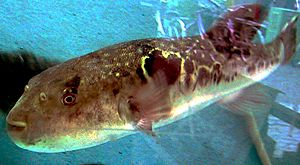Japanese puffer facts for kids
Quick facts for kids Japanese puffer |
|
|---|---|
 |
|
| Conservation status | |
| Scientific classification | |
| Synonyms | |
|
The Takifugu rubripes, also known as the Japanese puffer or Tiger puffer, is a type of pufferfish. In Japan, it's called torafugu (Japanese: 虎河豚). This fish is special because it has a very small genome. Scientists study its genome to learn more about human genes and other animals.
Contents
What's in a Name?
Sometimes, in science papers, this fish is called Fugu rubripes. But its proper scientific name is Takifugu rubripes. The name Takifugu comes from a Japanese word meaning "puffer." The second part, rubripes, comes from Latin words. Ruber means "ruddy" (reddish), and pēs means "foot."
Where Do They Live?
Japanese puffers live in the Sea of Japan, East China Sea, and Yellow Sea. You can find them as far north as southern Sakhalin. They usually live in water that is about 10–135 m (33–443 ft) deep. These fish are called "demersal" because they live close to the bottom of the ocean.
Life Cycle and Habitat
Japanese puffers lay their eggs in estuaries, which are places where rivers meet the sea. Young fish can live in water with different amounts of salt. They stay in river mouths and lagoons for about a year. After that, they move out to the open ocean for good.
The Amazing Genome
The Japanese puffer is famous for having a very small genome. A genome is like a complete set of instructions for building an organism. Scientists use the pufferfish's small genome as a "reference." This helps them find genes and other important parts in the genomes of humans and other animals.
In 2002, scientists finished mapping out the pufferfish's entire genome. It was the first time a vertebrate (an animal with a backbone) genome was made public after the human genome. The pufferfish genome is still one of the smallest known for a vertebrate. It has about 6% of the DNA of a human genome. Even though it's much smaller, it has a similar number of chromosomes (22) to humans (23). This makes it very useful for comparing with other animals.
Genetically Modified Pufferfish
Scientists have created a special type of torafugu called "22-seiki fugu." This fish has been genetically changed. It has four genes removed that control how much it eats. Because of this, the 22-seiki fugu eats more and grows faster. It grows about 1.9 times faster than a normal torafugu. These special fish are sold as food.
Is it Poisonous?
Like some other pufferfish, parts of the Japanese puffer contain a very strong poison called tetrodotoxin. This toxin can be very dangerous. The poison is mostly found in the liver and ovaries. There's a small amount in the intestines and flesh. However, the skin and testes (male reproductive organs) do not have this toxin.
Conservation Status
The Japanese puffer is listed as Near Threatened by the IUCN. This means it could become endangered in the future if we don't protect it. It's a very valuable fish for fishing in Japan. In 2004, about 101 tonnes were caught, which is much less than the 2,000 tonnes caught in 1987. Even though catches are smaller now, they might still be too high. This prevents the fish from recovering from being overfished in the past.
To help the species recover, experts have suggested some changes. These include rules about fishing gear, like using longline fishing less. They also suggest changing fishing seasons to protect young fish. Luckily, many Japanese puffers are now raised in aquaculture, which means they are farmed in special facilities. This helps reduce the pressure on wild populations.


